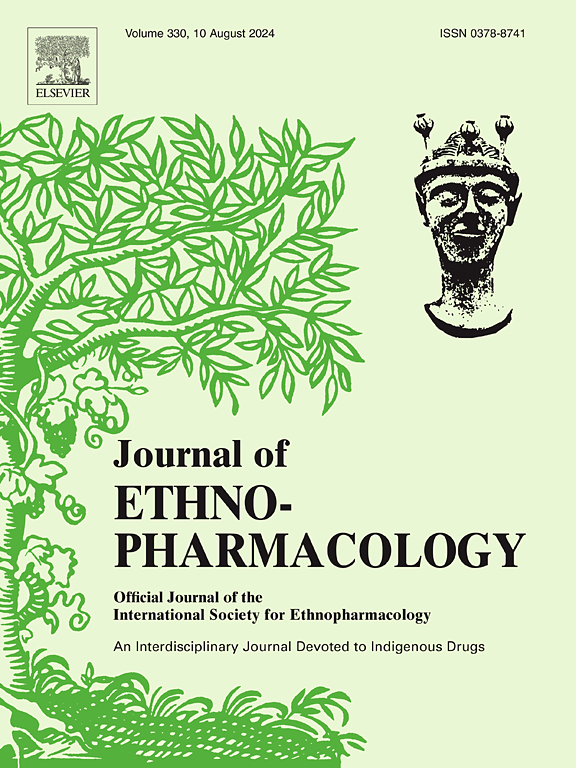S100A9/RAGE pathway regulation of mitophagy and the effect of JianPi LiShi YangGan formula in acute-on-chronic liver failure
IF 4.8
2区 医学
Q1 CHEMISTRY, MEDICINAL
引用次数: 0
Abstract
Ethnopharmacological relevance
Mitophagy regulates cellular homeostasis and liver inflammation; however, it is inhibited in acute-on-chronic liver failure (ACLF), which drives disease progression. The JianPi LiShi YangGan formula (YGF) has the potential to improve inflammatory responses and reduce mortality in patients with ACLF. However, the precise mechanisms underlying these effects remain unknown.
Aim of the study
We investigated the role of S100A9/RAGE signaling in mitophagy and the protective effects of traditional Chinese medicinal compounds on ACLF.
Materials and methods
An ACLF mouse model was established using carbon tetrachloride, lipopolysaccharide, and d-galactose. Hematoxylin and eosin staining and enzyme-linked immunosorbent assay were employed to evaluate the hepatoprotective effect of YGF in ACLF mice. Mitochondrial damage was assessed using transmission electron microscopy. Protein levels of mitophagy-related indicators were assessed through immunohistochemistry and western blotting, and immunofluorescence staining was performed to observe Lamp2 and COX-IV co-localization.
Results
The hepatocytes of ACLF mice contained damaged mitochondria, decreased mitophagy-related protein (Pink1, Parkin, and LC3B) expression and activated S100A9/RAGE signaling. Inhibiting S100A9 or RAGE improved liver injury in ACLF mice and enhanced Lamp2-COX-IV co-localization. In alpha mouse liver 12 (AML12) cells overexpressing RAGE, recombinant S100A9 protein inhibited mitophagy induced by 3-chlorocarbonyl benzoyl chloride. YGF reduced mitochondrial damage, increased Pink1, Parkin, and LC3B levels, and enhanced mitophagy while inhibiting S100A9/RAGE activation in the hepatocytes of ACLF mice.
Conclusions
This study found that S100A9/RAGE pathway activation impairs mitophagy, and YGF alleviates liver injury by downregulating S100A9 and RAGE signaling, which may be a novel therapeutic strategy for ACLF.

S100A9/RAGE通路对线粒体自噬的调节及健脾利血养肝方对急慢性肝衰竭的影响
自噬调节细胞稳态和肝脏炎症;然而,它在急性慢性肝衰竭(ACLF)中被抑制,ACLF驱动疾病进展。健脾利血养肝方(YGF)具有改善ACLF患者炎症反应和降低死亡率的潜力。然而,这些影响背后的确切机制尚不清楚。目的探讨S100A9/RAGE信号在线粒体自噬中的作用及中药复方对ACLF的保护作用。材料与方法采用四氯化碳、脂多糖、d-半乳糖建立ACLF小鼠模型。采用苏木精、伊红染色法和酶联免疫吸附法评价YGF对ACLF小鼠的肝保护作用。透射电镜观察线粒体损伤情况。通过免疫组织化学和western blotting检测自噬相关指标蛋白水平,免疫荧光染色观察Lamp2和COX-IV共定位。结果ACLF小鼠肝细胞线粒体损伤,线粒体自噬相关蛋白(Pink1、Parkin、LC3B)表达降低,S100A9/RAGE信号激活。抑制S100A9或RAGE可改善ACLF小鼠的肝损伤,增强Lamp2-COX-IV共定位。在过表达RAGE的α小鼠肝12 (AML12)细胞中,重组S100A9蛋白抑制3-氯羰基苯甲酰氯诱导的线粒体自噬。YGF降低了ACLF小鼠肝细胞线粒体损伤,增加了Pink1、Parkin和LC3B水平,增强了线粒体自噬,同时抑制了S100A9/RAGE的激活。结论本研究发现S100A9/RAGE通路激活可损害线粒体自噬,YGF通过下调S100A9和RAGE信号通路减轻肝损伤,可能是治疗ACLF的新策略。
本文章由计算机程序翻译,如有差异,请以英文原文为准。
求助全文
约1分钟内获得全文
求助全文
来源期刊

Journal of ethnopharmacology
医学-全科医学与补充医学
CiteScore
10.30
自引率
5.60%
发文量
967
审稿时长
77 days
期刊介绍:
The Journal of Ethnopharmacology is dedicated to the exchange of information and understandings about people''s use of plants, fungi, animals, microorganisms and minerals and their biological and pharmacological effects based on the principles established through international conventions. Early people confronted with illness and disease, discovered a wealth of useful therapeutic agents in the plant and animal kingdoms. The empirical knowledge of these medicinal substances and their toxic potential was passed on by oral tradition and sometimes recorded in herbals and other texts on materia medica. Many valuable drugs of today (e.g., atropine, ephedrine, tubocurarine, digoxin, reserpine) came into use through the study of indigenous remedies. Chemists continue to use plant-derived drugs (e.g., morphine, taxol, physostigmine, quinidine, emetine) as prototypes in their attempts to develop more effective and less toxic medicinals.
 求助内容:
求助内容: 应助结果提醒方式:
应助结果提醒方式:


